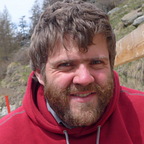Quantum computers in artificial universes
Quantum computers are always good for a headline. But if we really want to build them, creating new universes may be the way to go.
It might sound crazy, but it’s the science behind a host of recent experiments, including ones by Google and IBM. These seek to artificially create topological phases of matter, because they provide a nice way to keep track of any noise.
If topological phases sound familiar, you might be thinking of this year’s Nobel prize (the physics one, not the Bob Dylan one). The new laureates were pioneers in the study of the quasiparticles that arise in these strange forms of matter.
A quasiparticle is simply a local deformation of the material, which behaves exactly as if it were a particle. They even go so far as refusing to enter or leave existence unless accompanied by their antiparticle. Just like twisting a ribbon: You can’t make a twist on a closed loop without also creating an opposite twist. And when combined, they annihilate.
Quasiparticles in topological matter are rather more exotic than a twisted ribbon. For one thing they are usually allowed to move around in two dimensions, which gives them more freedom than in the claustrophobic 1D ribbon universe. But they are also restricted to these two dimensions, freeing them from a host of new mathematical rules that govern 3D universes like our own. The flatland is the sweet spot that lets particles truly shine. And so topological matter creates new universes whose laws of physics are much different from our own.
For one thing, the way you move the particles around becomes a lot more important. The order of the moves by which they dance around each other effects the outcome. This is something also true of many things in quantum mechanics, like the operations we perform on a quantum bit in a quantum computer. And also of the operations made by noise when our back is turned.
And herein lies the secret of their power. If we wish to capture the incomplete and noisy operations made in error, we must find something just as complex as they are. By building our quantum computer with topological matter, we can make it so that noise creates quasiparticles. And by choosing a phase with the right type of anyons, we know that they’ll be able to capture all aspects of the noise.
Once the subtle quantum noise has been turned into a rather obvious bunch of particles, we can do something about it. Just find the antiparticle for each particle, and get rid of them.
This is not so easy once you have a whole bunch of errors, and are racing against time to get old ones cleared up before new ones come. So there’s a fair bit of research these days to find the best methods to do this.
For some of the possible universes we can build, this needs lots of maths and head-scratching scientists. But for others, it is not so far beyond the ken of mortal men. In fact, there’s a whole new project that’s letting the public help out. It’s called Decodoku, and all you need to do is start shepherding the particles around on their apps. Those that share the secrets of their methods will be able to claim their place on the author’s list of publications based on the project. And a competition will also launch soon, giving participants a chance to win more tangible benefits as well.
So just because we are making new universes for our quantum computers, that doesn’t mean you can’t dive in and help.
This work is licensed under a Creative Commons Attribution 4.0 International License.
